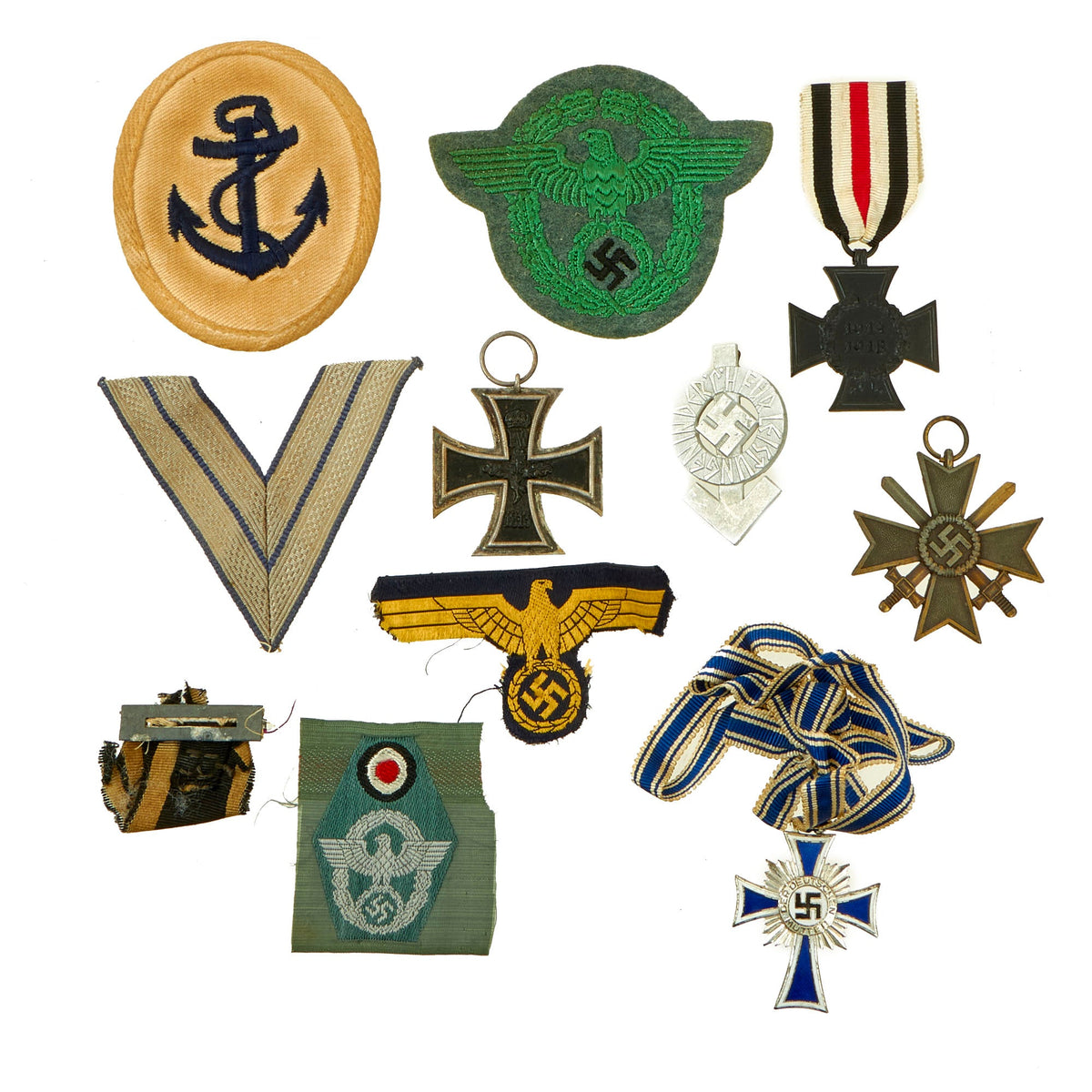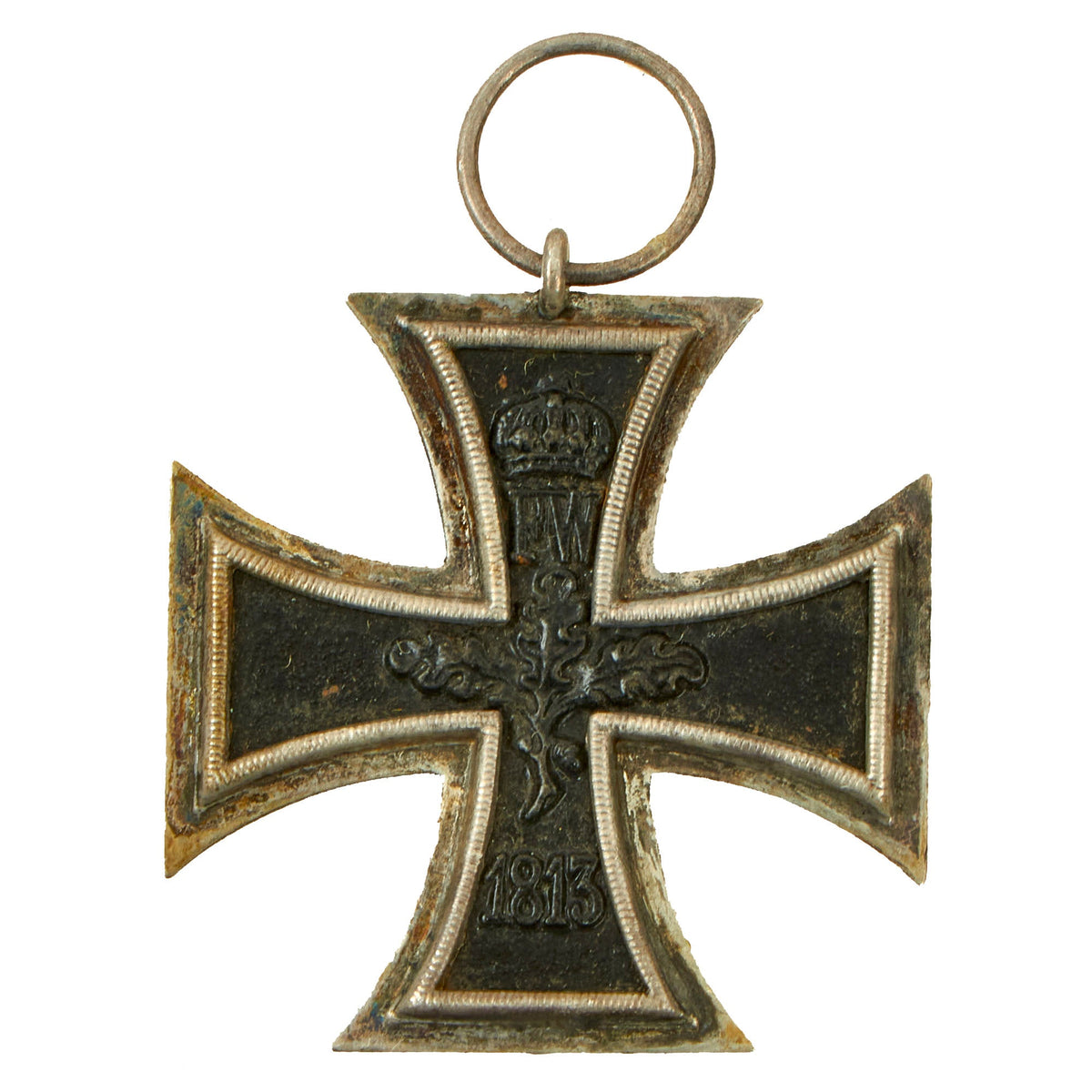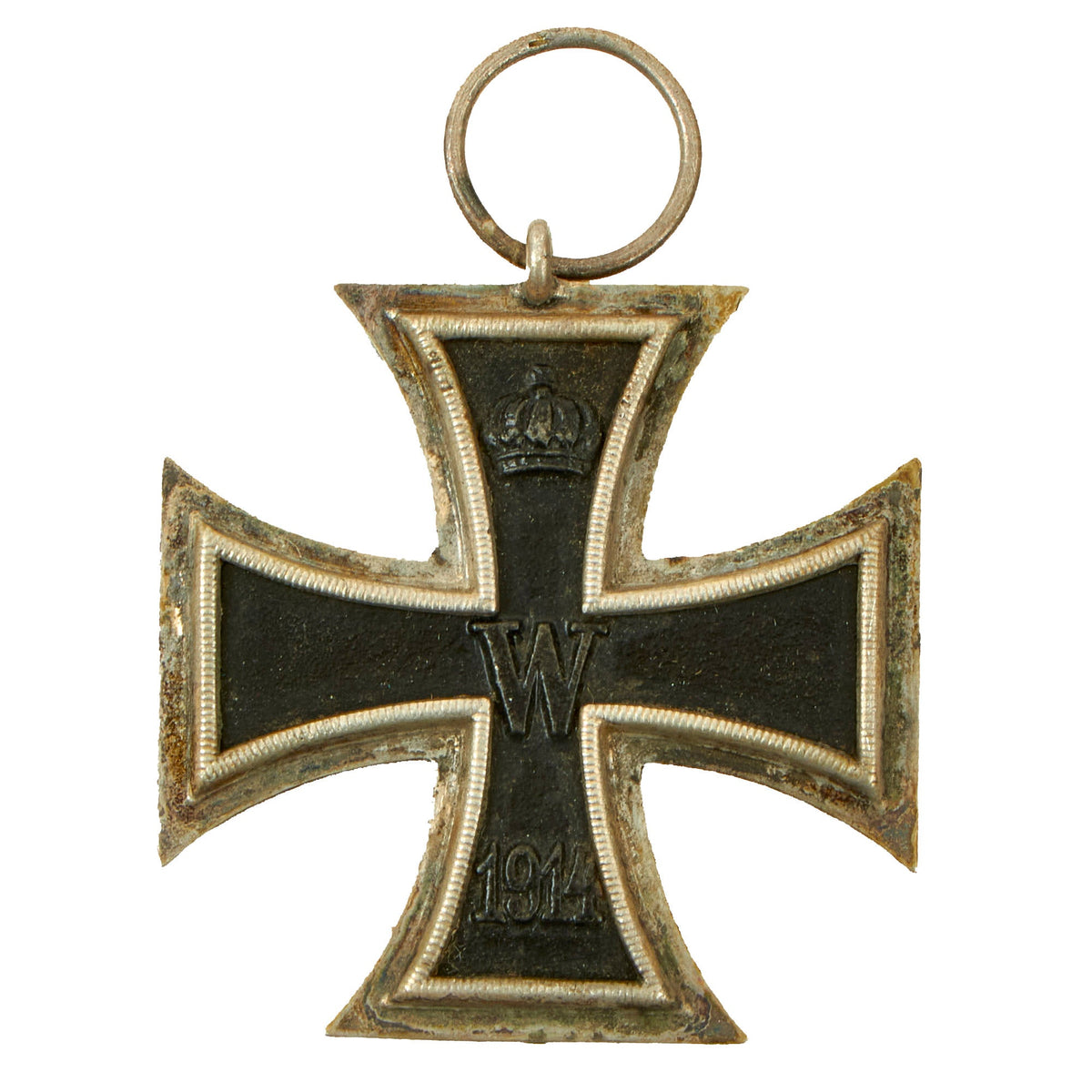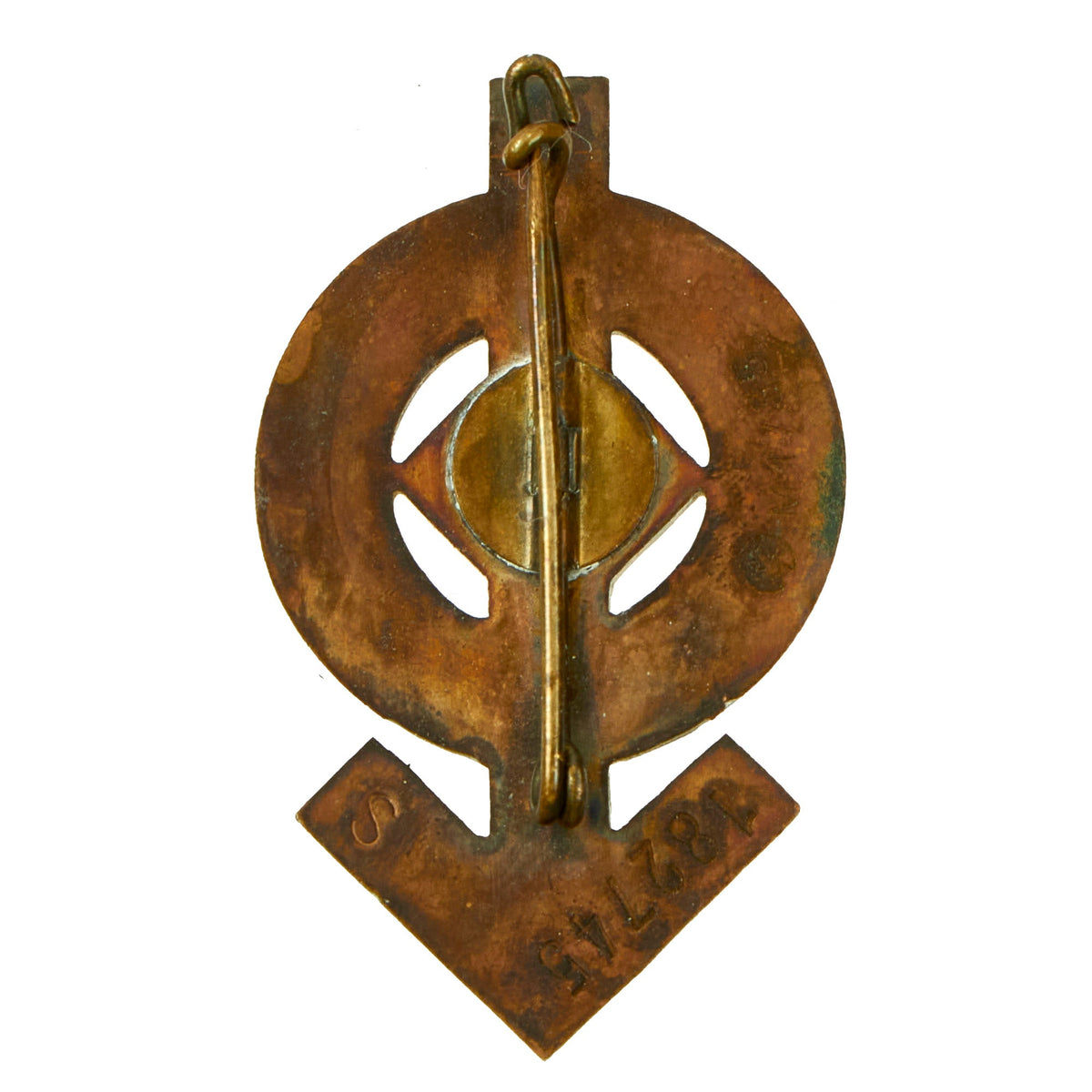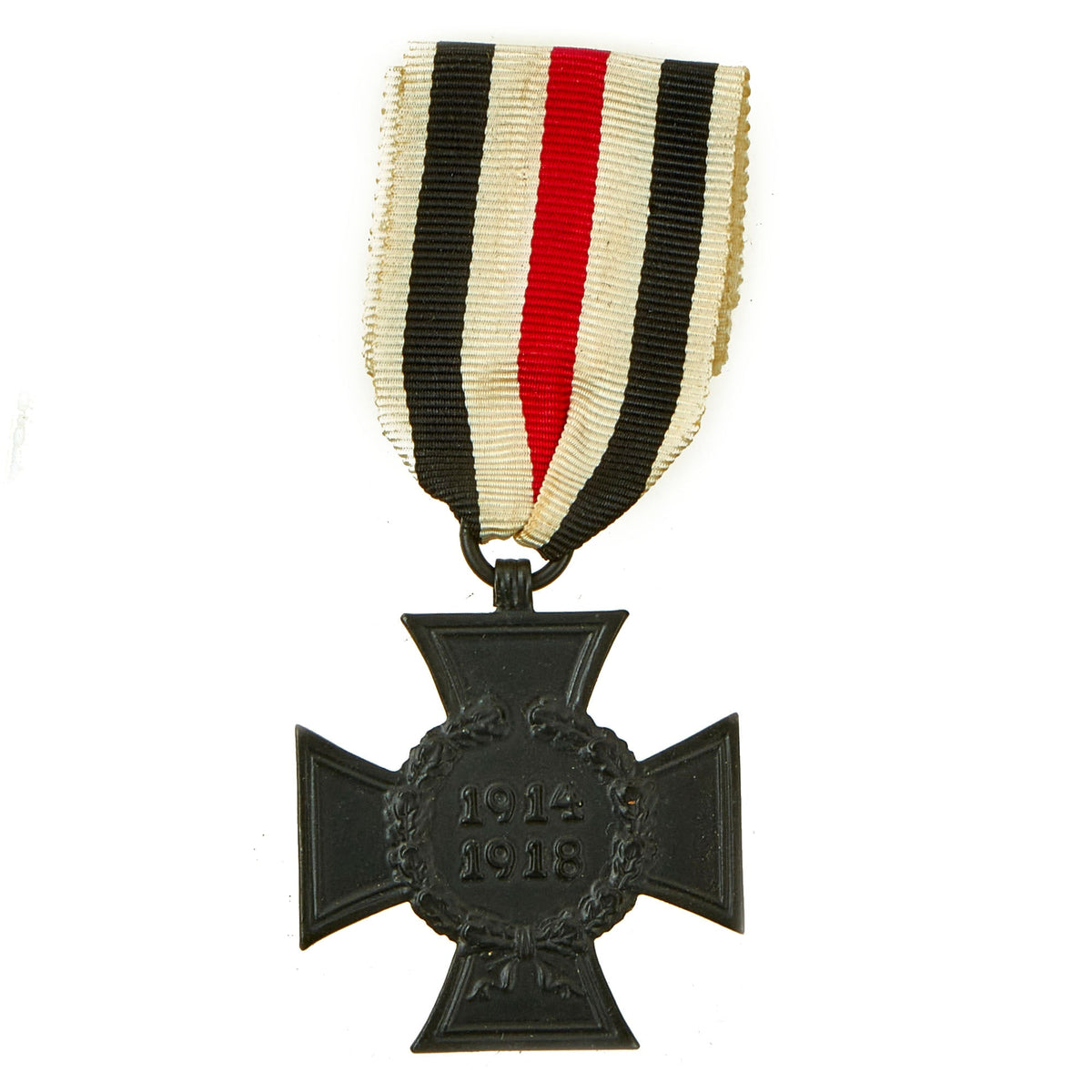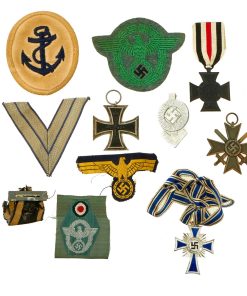Original German WWI & WWII Medal and Insignia Grouping with 1914 EKII and Widow’s Hindenburg Cross – 10 Items Original Items
$ 275,00 $ 110,00
Original Items: Only One Set Available. This is a very nice collection of German WWI, Interwar, and WWII era Insignia & Awards, which was brought back from the European theater by a USGI after the war was concluded. It includes some a wide variety of medals and insignia, including a WWI Iron Cross 1914 Second Class, Hindenburg Cross, War Merit Cross, and more!
This lovely set includes:
– One Imperial German WWI Iron Cross 1914 2nd Class Medal (Eisernes Kreuz II. Klasse 1918) with deteriorated detached ribbon. There is no maker stamped on the ring. There is some age to the paint and oxidation, but the silver is still present, with a lovely tarnished patina. The ribbon is in very delicate condition, and no longer attached to the medal.
– One Rare Pre-WWII German WWI Honor Cross of the World War 1914/1918 (Hindenburg Cross) Medal For Widows and Parents of Fallen Soldiers. Out of the 8 Million Crosses awarded, less than 10% were of this type, which has a magnetic black finished cross, and a ribbon without the outer black stripes. This example is in excellent condition, and is maker marked O16 on the back.
– One German WWII War Merit Cross 2nd Class with Swords (For Combat). – Missing Ribbon. Hanger Ring is not maker marked. The gold wash on the zinc body is about 25% retained.
– One German WWII Mothers Cross 2nd Class in Silver, for eligible mothers with 6 or 7 children. Much of the silver color is very well retained, and the enamel is in very good shape. It still has the original ribbon, stitched into a bow at the end.
– One WWII German WII HJ National Youth Organization Proficiency Badge In Silver. Marked on the back with number 182745 and maker marked RZM M1/35 for Wachtler & Lange of Mittweida. In very good condition.
– One German WWII Luftwaffe Air Force Mannschaften (Enlisted Men) Double Silver Chevron badge. This would be for a Obergefreiter (Airman First Class).
– One German WWII Bootsmannmaat Boatswain NCO’s Career Sleeve Insignia. For the Summer / White uniform, navy blue embroidered on white background. It has faded to beige over the years. Still maker marked on the back by Karl Hehler.
– One German WWII Kriegsmarine Navy BeVO Embroidered Breast Eagle (Uniform Cutoff). Correct Yellow Gold embroidery work on dark navy blue background.
– One German WWII Schutzpolizei Protection Police Sleeve Insignia with correct GREEN embroidery. Unissued condition with light staining.
– One German WWII NSDAP Civic Police M43 Feldmütze Field Cap BeVO Insignia Hexagon. Unissued condition. Combines the police eagle and tri-color cockade.
A wonderful totally genuine grouping perfect for the German Medal and Insignia collector.
German WWI Prussian Iron Cross 2nd Class with Ribbon:
Established by Frederick William in 1813 for gallantry in action, the decoration was revived several times for later conflicts. The bulk of the issues are divided into 1st and 2nd class versions, but a rare and superior ‘Grand Cross’ was also awarded for successful field commanders. During WW1 the lower decoration was freely awarded with 5½ million second class types issued. Originally, the Iron Cross was an award of the Kingdom of Prussia, however given Prussia’s pre-eminent place in the German Empire formed in 1871, it became an award for all of Germany.
The basic design of the WW1 crosses is a central Tatzenkreuz (cross pattée) struck from iron and mounted in a silver frame which has a raised crenulated decorative border. The obverse of the cross bears the date 1914 under a crowned ‘W’ monogram. Reverse bears an oak leaf cluster with the date of the decoration’s institution, 1813 underneath – the crowned initials of Frederick William are in the top arm above the oak leaf cluster. Suspension for second-class types is by means of a ring, and frequently this ring bears a maker’s stamp.
Please examine the edge seam for authentication, which is not present on reproductions. Iron crosses were commonly constructed from an iron core sandwiched in a surrounding two part silver frame, normally the seam of these two silver parts is visible around the edge of the cross as is seen on this fine example.
War Merit Cross 2nd Class (Kriegsverdienstkreuz) with Swords (for Combat)
This was a decoration of NSDAP Germany during the Second World War, which could be awarded to military personnel and civilians alike. By the end of the war it was issued in four degrees, and had a related civil decoration. It was created by Adolf AH in October 1939 as a successor to the non-combatant Iron Cross which was used in earlier wars. The award was graded the same as the Iron Cross: War Merit Cross Second Class, War Merit Cross First Class, and Knights Cross of the War Merit Cross. The award had two variants: with swords given to soldiers for exceptional service “not in direct connection with combat”, and without swords for meritorious service to civilians in “furtherance of the war effort”. As with the Iron Cross, Recipients had to have the lower grade of the award before getting the next level.
Hindenburg Cross:
The Honor Cross of the World War 1914/1918 (German: Das Ehrenkreuz des Weltkriegs 1914/1918), commonly, but incorrectly, known as the Hindenburg Cross was established by Field Marshal Paul von Hindenburg, President of the German Republic, by an order dated 13 July 1934, to commemorate the distinguished deeds of the German people during the First World War. This was Germany’s first official service medal for soldiers of Imperial Germany who had taken part in the war, and where they had since died it was also awarded to their surviving next-of-kin. Shortly after its issuance, the government of NSDAP Germany declared the award as the only official service decoration of the First World War and further forbid the continued wearing of German Free Corps awards on any military or paramilitary uniform of a state or NSDAP Party organization.
The Cross of Honour of the German Mother, referred to colloquially as the Mutterehrenkreuz (Mother’s Cross of Honor) or simply Mutterkreuz (Mother’s Cross), was a state decoration conferred by the government of the German Reich to honor a Reichsdeutsche German mother for exceptional merit to the German nation. Eligibility later extended to include Volksdeutsche (ethnic German) mothers from, for example, Austria and Sudetenland, that had earlier been incorporated into the German Reich.
The decoration was conferred from 1939 until 1945 in three classes: bronze, silver, and gold, to Reichsdeutsche mothers who exhibited probity, exemplary motherhood, and who conceived and raised at least four or more children in the role of a parent. A similar practice, that continues to this present day, was already established in France since 1920, by conferring the Médaille de la Famille française (Medal of the French Family), a tribute to the French mother who raised several children in an appropriate way.
In recognition of the substantial importance a woman’s role and motherhood was in support of a strong Germany, the Cross of Honor of the German Mother was introduced by decree in Berlin on 16 December 1938 by Führer und Reichskanzler (leader and chancellor) AH. The preamble of the statutory decree declared:
As a visible sign of gratitude of the German nation to children-rich mothers I establish this Cross of Honor of the German Mother
The crosses were awarded annually on the second Sunday in May (Mothering Sunday or Mother’s Day), but also extended to include other national annual occasions of celebration. So despite its institution in 1938, the first awards were rendered in May 1939.
The Mother’s Cross was composed of three classes, and conferred to mothers in accordance with its statutory legislation: Verordnung des Führers und Reichskanzlers über die Stiftung des Ehrenkreuzes der Deutschen Mutter vom 16. Dezember 1938. Reichsgesetzblatt (RGBI) Teil I, 1938, Nr. 224, Seite 1923 (In English: Statutory Order of the Leader and Chancellor on the establishment of the Cross of Honor of the German Mother of 16 December 1938. Imperial-(Reichs) Law Gazette (RGBl) Part I, 1938, No. 224, Page 1923), and its stringent nomination screening protocol.
Classes
-1st class, Gold Cross: eligible mothers with eight or more children
-2nd class, Silver Cross: eligible mothers with six or seven children
-3rd class, Bronze Cross: eligible mothers with four or five children
The cross design is a slender elongated form of the Iron Cross or cross pattée and very similar in design to the Marian Cross of the Teutonic Order, enameled translucent-blue with a slim opaque-white border. Resting on the center radiant starburst rays is a metal roundel decorated with the words DER DEUTSCHEN MUTTER (in English: TO THE GERMAN MOTHER) around an enameled black straight centered “swas” symbol, infilled white enamel. Reverse of medal reads 16 December 1938, which is the date that the award was first established, along with AH’s Signature.
The cross design was the creation of the established Munich-based architect and sculptor Franz Berberich. The production of the cross involved several established Präsidialkanzlei (Presidential Chancellery) approved medal makers from across the German Reich. A maker’s mark was never applied to the crosses produced; though each official house of manufacture did apply their name to the dark-blue presentation case (inside cover) for the 1st Class Gold Cross and the presentation sachets (reverse side) for each of the 2nd and 3rd Class Cross.
Fast Shipping with Professional Packaging
Thanks to our longstanding association with UPS FedEx DHL, and other major international carriers, we are able to provide a range of shipping options. Our warehouse staff is expertly trained and will wrap your products according to our exact and precise specifications. Prior to shipping, your goods will be thoroughly examined and securely secured. We ship to thousands clients each day across multiple countries. This shows how we're dedicated to be the largest retailer on the internet. Warehouses and distribution centres can be located throughout Europe as well as the USA.
Note: Orders with more than one item will be assigned a processing date depending on the item.
Before shipping before shipping, we'll conduct a thorough inspection of the items you have ordered. Today, the majority of orders will be delivered within 48 hours. The delivery time will be between 3-7 days.
Returns
The stock is dynamic and we cannot completely manage it because multiple stakeholders are involved, including our factory and warehouse. So the actual stock may alter at any time. It's possible that you may not receive your order once the order has been made.
Our policy is valid for a period of 30 days. If you don't receive the product within 30 days, we are not able to issue a refund or an exchange.
You can only return an item if it is unused and in the same state as the day you received it. You must have the item in its original packaging.
Related products
Uncategorized
Uncategorized
Uncategorized
Angolan Rebel 1970s era 60mm Inert Display Mortar from Angolan Civil War Original Items
Uncategorized
Uncategorized
Uncategorized
Uncategorized
Band of Brothers ORIGINAL GERMAN WWII Le. F.H. 18 10.5cm ARTILLERY PIECE Original Items
Uncategorized
Uncategorized
Uncategorized
Uncategorized
Uncategorized
Uncategorized
Uncategorized
Uncategorized
Australian WWII Owen MK1 Machine Carbine SMG Custom Fabricated Replica with Sling Original Items
Uncategorized
Armored Burgonet Helmet & Polearm from Scottish Castle Leith Hall Circa 1700 Original Items
Uncategorized
